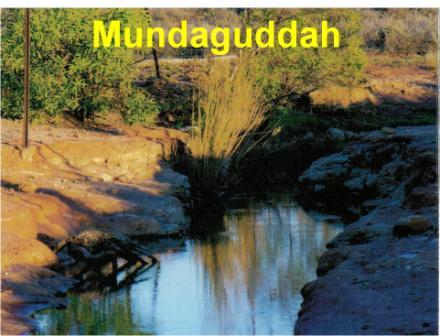Aunty Doris' 8way yarns
Aunty Doris Shillingsworth enjoys sharing many of her yarns and inherited Dreaming stories. Aunt applies all her knowledge about Culture way through her ways of doing and learning, to teach the younger generation how to respect Country and feel their way through it. 100% of the time,children listen to Aunty Doris and are keen and curious about how it all works. Aunty tells the story of the Mundagutta from Murrawarri tradition, which gives teachers and students an understanding of discipline and respect. It also shows how to to learn from the land, particularly from paying attention to the way water moves on country. Many schools include "respect" as part of their school rules, but often the meaning is shallow or misunderstood. Aunty brings knowledge about what water can teach us about respect. When this is applied to school values, it makes a huge difference to behaviour, safety and relationships.
The Murrawarri people tell the story of a being called Mundaguddah. When the water in springs increases, the spirit of the Mundaguddah is passing by. Mundaguddah is a spirit of omens, discipline and respect. The Mundaguddah travels the billabongs, rivers, swamps, waterholes and springs and gives early warnings to people in the area that the rivers will soon flood. In this photo you can see the Artesian springs at Old Gerara north of Bourke. When the water level rises it is a sign that Mundaguddah is moving through the area.
When Elders want to teach and instill into children discipline and respect, the children are told that the Mundaguddah will be angry if the children disobey their wishes or break any rules. Also if the children sneak away or go swimming by themselves then the Mundaguddah spirit can get them or come to them in their dreams. These songs and Dreaming stories are handed down from generation to generation. All are still told today and form the essence of a Murrawarri man or woman.
Here's a couple of yarns Aunty received recently at the Bangamalanha Centre in some materials from the "Deadly Ways" mob at DET in WA. They are about the "deconstruct/reconstruct" way of learning.
Some of the ladies took me out collecting honey ants from time to time. I was always shown where to sit, and was expected to watch. It wasn't until about the fith time I went out with them that they let me have a go at digging. I was given the shovel, and did as I'd been shown but the shovel was quickly taken back again and I was told to go and sit some more. Apparently, I hadn't done it properly. There was no verbal instruction, no little tips, but I got there in the end.
Sam
I learned the hard way that you have to introduce the whole task before trying to break it down into component parts. I was teaching the structure of procedural texts to my students. I modeled all the steps involved and we discussed them. The students then proceeded to follow the steps on the chart. After about forty minutes, during which I was asked to constantly repeat the steps to individual students, I realised that the process was not working. I then modeled a completed procedural text for my students and put it on the wall where they could all see it. The students then easily completed the task with little assistance from me.
Jeanette
Seven-year-old Bartholomew Maru came bounding in one day, excitedly telling the story of an experience he’d had on his way to school that morning. I asked him if he would like to write down the story. Bart had difficulty with reading and writing, not progressing beyond the most basic early learning level. I had suspected for some time that he was not a logical linear thinker; his style was more visuo–spatial. While a wonderful raconteur, musician and artist,
Bartholomew had difficulty absorbing and applying the phonic method of language
construction. I asked him to draw the story. As he sketched all the elements into a
quite detailed picture, he related each action and context.
‘Man try to hang himself on the footbridge. Him hanging over the side of that
railing. Guard run up the steps. Train come in the station. Guard release him and
pull him back. He right now. Nothing bad. We was just going over the footbridge
and it happened then’
I labelled his drawing at the point of each action. Man. Footbridge. Railing. Guard.
Steps. Train. Platform. Bart. Then, using another colour I inserted action words
next to the nouns. Hanging. Run. Come. Release. Pull. I asked Bart to look at the
picture and the words that labelled the elements, then to copy the words in the same
arrangement as on his drawing to a blank page. On another page I wrote the same
words in two lists and asked him to read them, and copy them out again. Finally, I
dictated the words for him to write. After half an hour he recalled all the words.
Yet, a simple word list of three-letter words brought home from school proved
much more taxing. Bart recalled the entire scene, drew it adeptly with considerable
detail, related the action (without regard for tense) and was very quick to
reproduce words (and later, phrases).
Hannah Rachel Bell



